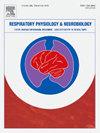Respiratory effects of obesity on the ventilatory response to exercise in older adults: the impact of a shift in operational lung volumes
IF 1.6
4区 医学
Q3 PHYSIOLOGY
引用次数: 0
Abstract
We examined the exercise ventilatory response to heavy exercise (ventilation [V̇E] and carbon dioxide elimination [V̇CO2] relationship from ventilatory threshold to peak exercise) and operational lung volumes (end expiratory [EELV] and end inspiratory [EILV]) in older adults with and without obesity. Forty-nine older adults with (BMI: 33.9 ± 5.0 kg/m2, age: 70 ± 2 y) and without obesity (BMI: 24.6 ± 3.0 kg/m2, age:71 ± 3 y) were evaluated, and performed a maximal incremental cycling test. The V̇E/V̇CO2 slope was lower in those with (43.1 ± 8.0) vs. without obesity (51.4 ± 11.1). While EELV was lower in those with (52.4 ± 6.1 %TLC) vs. without obesity (58.9 ± 5.8 %TLC), EILV was similar (with obesity: 88.2 ± 4.5 vs. without obesity: 89.2 ± 4.2 %TLC) between groups. EELV increased more from rest to peak exercise in those with obesity (0.23 ± 0.30 L: vs. −0.1 ± 0.4 L). Our findings demonstrate that the ventilatory response to heavy exercise is blunted in older adults with obesity, which appears to be associated with an increasing EILV encroaching on TLC.
肥胖对老年人运动后通气反应的呼吸效应:手术肺容量变化的影响
我们研究了有肥胖和没有肥胖的老年人对大运动量运动的运动通气反应(通气[V (E)]和二氧化碳消除[V (CO2)]从通气阈值到运动峰值的关系)和操作肺容量(呼气末[EELV]和吸气末[EILV])。49老年人和(BMI: 33.9 ±5.0 kg / m2,年龄:70年 ±2 y)和没有肥胖(体重指数:24.6 ±3.0 kg / m2,年龄:71年 ± 3 y)进行评估,并进行了最大增量循环试验。肥胖组(43.1 ± 8.0)与非肥胖组(51.4 ± 11.1)相比,V (E) /V (CO2)斜率较低(43.1 ± 8.0)。虽然EELV在那些低(52.4 ±6.1 % TLC)与没有肥胖(58.9 ±5.8 % TLC), EILV相似(与肥胖:88.2 ± 4.5 vs没有肥胖: 89.2±4.2 % TLC)之间的组。肥胖患者的EELV从休息到运动高峰增加更多(0.23 ± 0.30 L vs. - 0.1 ± 0.4 L)。我们的研究结果表明,肥胖老年人对剧烈运动的通气反应减弱,这似乎与EILV增加侵犯TLC有关。
本文章由计算机程序翻译,如有差异,请以英文原文为准。
求助全文
约1分钟内获得全文
求助全文
来源期刊
CiteScore
4.80
自引率
8.70%
发文量
104
审稿时长
54 days
期刊介绍:
Respiratory Physiology & Neurobiology (RESPNB) publishes original articles and invited reviews concerning physiology and pathophysiology of respiration in its broadest sense.
Although a special focus is on topics in neurobiology, high quality papers in respiratory molecular and cellular biology are also welcome, as are high-quality papers in traditional areas, such as:
-Mechanics of breathing-
Gas exchange and acid-base balance-
Respiration at rest and exercise-
Respiration in unusual conditions, like high or low pressure or changes of temperature, low ambient oxygen-
Embryonic and adult respiration-
Comparative respiratory physiology.
Papers on clinical aspects, original methods, as well as theoretical papers are also considered as long as they foster the understanding of respiratory physiology and pathophysiology.

 求助内容:
求助内容: 应助结果提醒方式:
应助结果提醒方式:


